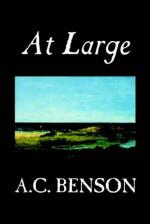“I confess,” said Musgrave, laughing, “that that statement conveys nothing to me. A painter, on that line, would depict nothing, but simply produce a sort of harmony of colour. A picture would become simply a texture of colour-vibrations. My own view is rather that it is a question of accurate observation, followed by an extreme delicacy and suggestiveness of expression. Some people would say that it was all a question of reality; and that the point is that the writer shall suggest a reality to his reader, even though the picture he evoked in the reader’s mind was not the same as the picture in his own mind—but that is to me pure symbolism.”
“Exactly,” said Herries, “and the more symbolical that art becomes, the purer it becomes—that is precisely what I am aiming at.”
“Well,” I said, “that gives me an opportunity of making a confession. I have never really been able to understand what technical symbolism in art is. A symbol in the plain sense is something which recalls or suggests to you something else; and thus the whole of art is pure symbolism. The flick of colour gives you a distant woodland, the phrase gives you a scene or an emotion. Five printed words upon a page make one suffer or rejoice imaginatively; and my idea of the most perfect art is not the art which gives one a sense of laborious finish, but the art in which you never think of the finish at all, but only of the thing described. The end of effort is to conceal effort, as the old adage says. Some people, I suppose, attain it through a series of misses; but the best art of all goes straight to the heart of the thing.”
“Yes,” said Musgrave, “my own feeling is that the mistake is to consider it can only be done in one way. Each person has his own way; but I agree in thinking that the best art is the most effortless.”
“From the point of view of the onlooker, perhaps,” said Herries, “but not from the point of view of the craftsman. The pleasure of art, for the craftsman, is to see what the difficulty was, and to discern how the artist triumphed over it. Think of the delightful individual roughness of old work as opposed to modern machine-made things. There is an appropriate irregularity, according to the medium employed. The workmanship of a gem is not the same as that of a building; the essence of the gem is to be flawless; but in the building there is a pleasure in the tool-dints, like the pleasure of the rake-marks on the gravel path. Of course music must be flawless too—firm, resolute, inevitable, because the medium demands it; but in a big picture—why, the other day I saw a great oil-painting, a noble piece of art—I came upon it in the Academy, by a side door close upon it. The background was a great tangled mass of raw crude smears, more like coloured rags patched together than paint; but a few paces off, the whole melted into a great river-valley, with deep water-meadows of summer grass and big clumps of trees. That is the perfect combination. The man knew exactly what he wanted—he got his effect—the structure was complete, and yet there was the added pleasure of seeing how he achieved it. That is the kind of finish I desire.”




